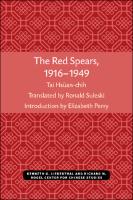The Red Spears, 1916–1949
| dc.contributor.author | Tai, Hsuan-chi | |
| dc.contributor.author | Tai, Hsuan-chih | |
| dc.date.accessioned | 2020-09-23T15:16:42Z | |
| dc.date.available | 2020-09-23T15:16:42Z | |
| dc.date.issued | 2020 | |
| dc.identifier | ONIX_20200923_9780472901876_33 | |
| dc.identifier | OCN: 562599778 | |
| dc.identifier.uri | https://library.oapen.org/handle/20.500.12657/41837 | |
| dc.description.abstract | Before Tai Hsüan-chih’s work on the Red Spear Society, the subject was a little understood movement that seemed of only passing interest to scholars of China—intriguing for its peculiar beliefs and rituals, perhaps, but hardly of central importance to modern Chinese history. Today, however, thanks in no small measure to the pioneering work of Professor Tai, the Red Spears have gained a secure niche in scholarship on modern China. Their numbers (reaching perhaps some three million participants at the height of the movement) and enduring (lasting intermittently for several decades) should stand as reason enough for the recent scholarly attention. But the Red Spears have generated interest for other reasons as well. As research has developed into the history both of China’s traditional rural rebellions and of her Communist revolution has developed over the past few years, the Red Spears have assumed increasing significance. A movement which bore marked similarities to earlier Chinese uprisings (most notably the Boxers), the Red Spears nevertheless operated in a later period of history (right through the middle of the twentieth century) which brought them in direct contact with Communist revolutionaries. An analysis of the Red Spears thus becomes important both for what it can tell us about longstanding patterns of rural rebellion in China, and for what it suggests about the nature of Chinese revolution. | |
| dc.language | English | |
| dc.relation.ispartofseries | Michigan Monographs In Chinese Studies | |
| dc.subject.classification | thema EDItEUR::N History and Archaeology::NH History | en_US |
| dc.subject.other | History | |
| dc.title | The Red Spears, 1916–1949 | |
| dc.type | book | |
| oapen.identifier.doi | 10.3998/mpub.19970 | |
| oapen.relation.isPublishedBy | e07ce9b5-7a46-4096-8f0c-bc1920e3d889 | |
| oapen.relation.isFundedBy | 0314e571-4102-4526-b014-3ed8f2d6750a | |
| oapen.relation.isFundedBy | 0cdc3d7c-5c59-49ed-9dba-ad641acd8fd1 | |
| oapen.imprint | U OF M CENTER FOR CHINESE STUDIES | |
| oapen.series.number | 54 | |
| oapen.pages | 187 | |
| oapen.place.publication | Ann Arbor | |
| oapen.grant.number | [grantnumber unknown] | |
| oapen.grant.number | [grantnumber unknown] | |
| peerreview.anonymity | test | |
| peerreview.anonymity | Double-anonymised | |
| peerreview.id | d98bf225-990a-4ac4-acf4-df7bf0dfb00c | |
| peerreview.open.review | No | |
| peerreview.publish.responsibility | Scientific or Editorial Board | |
| peerreview.review.decision | Yes | |
| peerreview.review.stage | Pre-publication | |
| peerreview.review.type | Full text | |
| peerreview.reviewer.type | External peer reviewer | |
| oapen.review.comments | The proposal was selected by the acquisitions editor who invited a full manuscript. The full manuscript was reviewed by two external readers using a double-blind process. Based on the acquisitions editor recommendation, the external reviews, and their own analysis, the Executive Committee (Editorial Board) of U-M Press approved the project for publication. |

